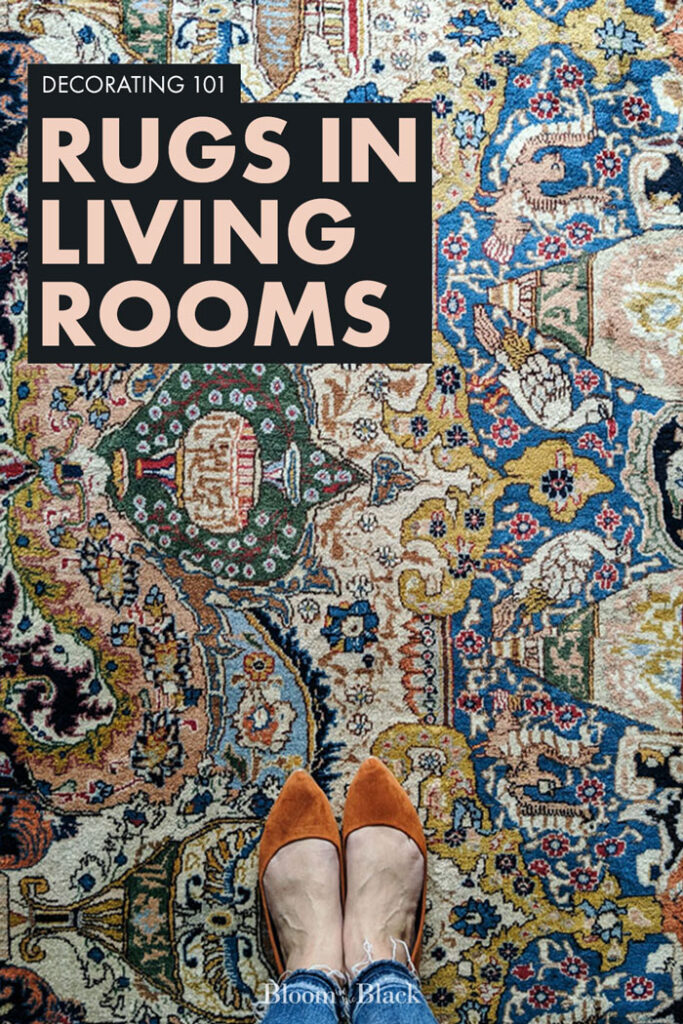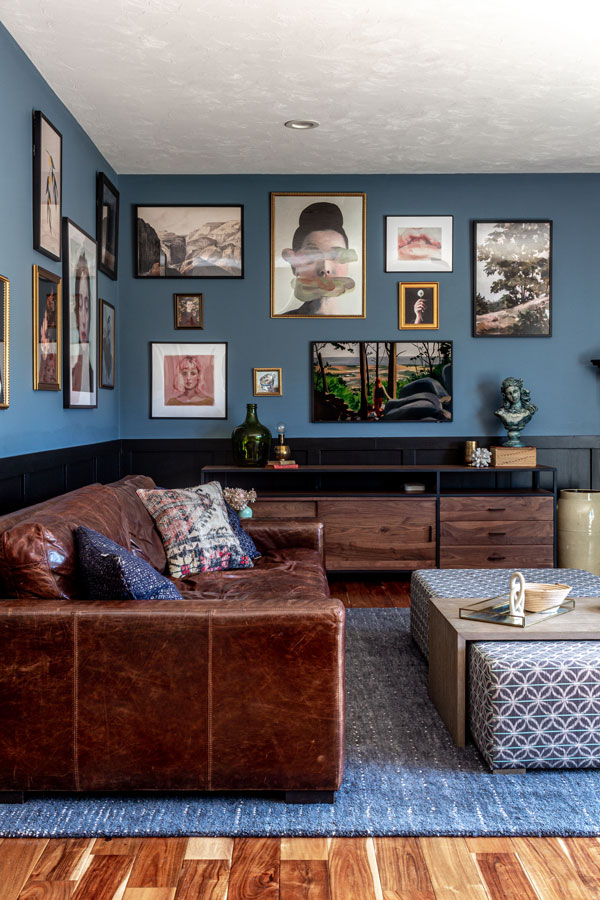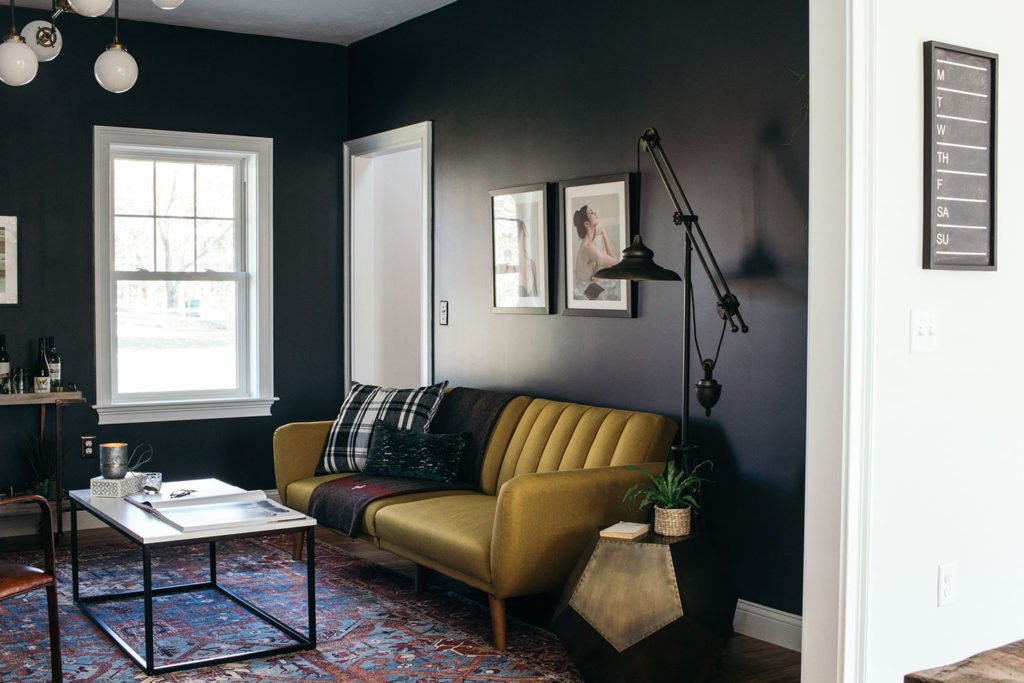Does a Living Room Need an Area Rug? How To Decide
Soft underfoot and offering a dash of color, area rugs can brighten up any room. But is it possible to create a warm and cozy living room without adding an area rug?
It’s not essential to have an area rug in a living room, especially if it’s a compact space or already carpeted. Area rugs provide the most benefit on hard flooring or in larger rooms.
Even if it’s not absolutely crucial to have an area rug in your living room, you might still want to consider it anyway. Area rugs offer lots of potential benefits, but it’s imperative to choose the right color and size. Here’s a look at whether to add a rug to your living room and how to decide.
Pin for later!

This post contains some affiliate links for your convenience. Click here to read my full disclosure policy. Thanks for supporting Bloom in the Black!
Should You Have an Area Rug in Your Living Room?
We’ve all seen those homes which are stuffed uncomfortably full, and end up looking cramped rather than cozy. If you jam in a rug that’s the wrong color or size, this can create the same unpleasant effect.
If you prefer not to have a rug, you’re not destined to have a cold and soulless living room. There are plenty of other ways to create texture and color in your space without the addition of an area rug. Floor cushions and carpeted flooring are two alternatives that you could consider instead of an area rug.
But some people love rugs and can’t imagine a room without one. The good news is that if you make a smart choice, it’s possible to find a complementary area rug for every living room. Size, color, and style will all help to determine whether your area rug looks frightful or fabulous.
There’s no single, definitive answer about whether you should add an area rug to your living room. Much depends on your personal taste, the size of your living room, your existing decor, and other factors, which I’m going to cover in more detail now.

Factors To Consider for a Living Room Area Rug
Like many things, there are pros and cons to an area rug for your living room. Below are the main points you might want to consider:
Pros
- Area rugs accentuate your decor. No matter whether your decor is classic or contemporary, a rug will complement your room and bring it to the next level.
- Area rugs add warmth. Rugs can trap heat, making the room feel warmer and reducing heating costs.
- Soft flooring improves insulation. Better insulation helps to prevent sound from traveling, providing you with more privacy and reducing complaints from neighbors.
- Area rugs can easily be changed. If you like to switch up your decor regularly, area rugs are very easy to change and can completely alter the appearance of your room.
- Area rugs add softness and comfort. Hard flooring isn’t very comfortable to sit on and can be cold underfoot. An area rug is soft, comfortable, and cozy for both bottoms and feet!
- Area rugs provide a focal point. Furniture can sometimes appear to be “floating” around the room without an anchor. A rug provides a central focal point for the eye.
- Area rugs can protect the floor. Hard flooring can mark and scratch over time — not the best look. An area rug can cover up existing marks as well as provide protection from future damage.
- Area rugs are available in different materials. It’s possible to choose a low-maintenance material to make cleaning quick and easy.
Read my guide on which types of rugs are the easiest (and hardest) to clean.
Cons
- The wrong area rug can clash with your decor. If you don’t pick the right rug, it will either crowd the room or look terrible with the rest of your furniture and decor.
- Rugs require more maintenance than hard flooring. Even though rugs are easier to clean than a full carpet, they still take more work to look after than a hard floor.
- They may begin to show signs of wear and tear. The living room is a high-traffic area, so you’ll need to choose a hard-wearing rug to prevent signs of wear and tear from appearing too quickly.
- Your room already has visual dividers. If your living room is quite small and is already split into visual sections, a rug may make the space seem cluttered.
- Some household members have mobility difficulties. Rugs can be a trip hazard for anyone with mobility challenges and can be harder for a wheelchair to move over.

How To Decide on a Living Room Area Rug
If you’re considering an area rug for your living room, the following steps will help you decide.
1. Think About Your Personal Preferences
Put simply, if you don’t like area rugs, then it’s pointless going through the motions of trying to find one that you can imagine in your home. Some people just don’t like the look of rugs, and nothing will change their minds.
This was me in my 20s, to be honest. Wasn’t a fan!
If this sounds like you, check out alternatives such as fully carpeted flooring, beanbags, or floor cushions. All of these will add texture, warmth, and interest to a living room floor.
However, one word of caution…
If you’ve never had area rugs, make sure that you’re not ruling out the idea based on poor choices you’ve seen IRL. Search Pinterest to check out a wide range of area rugs. You might surprise yourself and find a rug style that you really love.
2. Factor in Any Mobility Issues
If you have anyone in the household with mobility issues, you should think very carefully before adding an area rug to your living room. An area rug may seem beneficial because of its softer surface, but it can be problematic for anyone who struggles to get around.
Rugs can be difficult for wheelchairs to move over and can get caught up in the wheel spokes. They can also present a trip hazard for anyone with walking difficulties or using a walking aid.
It’s possible to get grippers and other aids to stop rugs from slipping or bunching up. These can be invaluable if you’ve got young children in your home. However, grippers, tape or other anti-slip devices are rarely sufficient to prevent rugs from being a hazard for wheelchair users and those with impaired mobility.
3. Consider Your Reasons for Adding an Area Rug
If you don’t currently have an area rug, what are your reasons for adding one? Are you looking to add a splash of color and finish off your existing decor? Or are you hoping to add some softness underfoot and make your flooring feel warmer?
Once you know what you are trying to achieve, you can look for an area rug that ticks all of your boxes. It might even lead you to alternative solutions. For example, if you want your living room to feel warmer, a fully carpeted floor may be preferable.
4. Get an Accurate Measurement of Your Living Room
Although it’s possible to add a rug to most living rooms, it can be more difficult in a smaller space. A highly patterned area rug could dominate your decor or make the room seem smaller than it really is. Listen, I love a maximalist moment, but be particularly careful when considering a rug for tiny living rooms.
An accurate measurement is vital before buying an area rug, regardless of the size of your living room. The rug shouldn’t be too small or too big, or else it will look ill-fitting. Make sure there is at least 10-24 inches (25-60 cm) between the rug and the edge of the room. This gap prevents the area rug from looking like a full carpet that’s shrunk in the wash!
This article by Emily Henderson provides a great guide to choosing the right size rug.
5. Use a Visualizer Tool
If you’re struggling to decide whether to add an area rug to your living room, use a visualizer tool online. This will allow you to experiment with different rugs to find the color, size, and style that works for your living room.
Final Thoughts
If you really don’t want an area rug in your living room, no one is going to call the home decor police if you don’t get one. There are many valid reasons for preferring to keep your home rug-free, and you don’t have to sacrifice style to do so.
However, rugs can add a beautiful accent to any living room, as well as having many practical benefits too. If you have hard flooring in your home, an area rug is usually an excellent idea. Stylish, warm, and low maintenance, an area rug can add that missing touch to any living room space.
